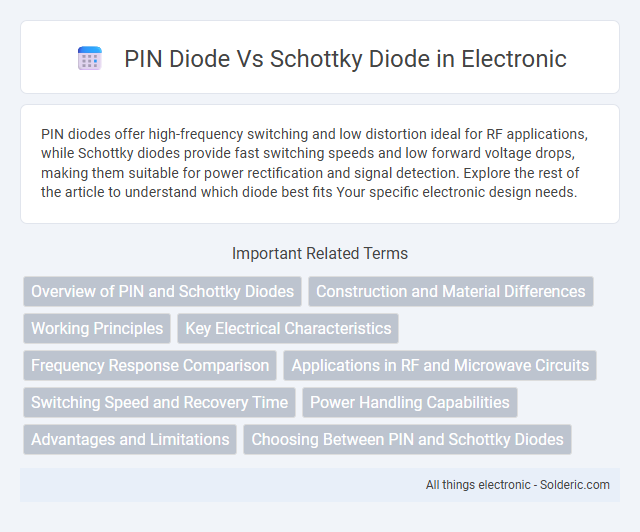PIN diodes offer high-frequency switching and low distortion ideal for RF applications, while Schottky diodes provide fast switching speeds and low forward voltage drops, making them suitable for power rectification and signal detection. Explore the rest of the article to understand which diode best fits Your specific electronic design needs.
Comparison Table
| Feature | PIN Diode | Schottky Diode |
|---|---|---|
| Structure | p-type, intrinsic, n-type layers | Metal-semiconductor junction |
| Forward Voltage Drop (Vf) | ~0.7 to 1.0 V | ~0.2 to 0.3 V |
| Switching Speed | Slower, suitable for RF applications | Faster, low capacitance |
| Reverse Recovery Time | Longer | Extremely short |
| Applications | RF switches, attenuators, photodetectors | Power rectifiers, clamping circuits, high-speed switching |
| Leakage Current | Low | Higher than PIN diode |
| Power Handling | High power capabilities | Moderate power handling |
Overview of PIN and Schottky Diodes
PIN diodes feature an intrinsic layer between the p-type and n-type regions, offering high-frequency switching and low capacitance ideal for RF and microwave applications. Schottky diodes utilize a metal-semiconductor junction, providing faster switching speeds and lower forward voltage drop, making them suitable for power rectification and high-speed circuits. Both diodes serve distinct roles in electronics, with PIN diodes excelling in signal modulation and Schottky diodes favored for efficiency in fast switching tasks.
Construction and Material Differences
PIN diodes feature a layered structure consisting of an intrinsic semiconductor sandwiched between p-type and n-type regions, using silicon as the primary material to provide high-frequency switching and low capacitance. Schottky diodes employ a metal-semiconductor junction, typically combining metals like platinum or gold with n-type silicon, resulting in faster switching speeds and lower forward voltage drops. Your choice between these diodes depends on the required electrical characteristics, as the distinct construction and material choices directly impact performance in RF and switching applications.
Working Principles
PIN diodes operate using an intrinsic layer between the p-type and n-type semiconductor regions, which increases the depletion region and controls the flow of charge carriers, making them ideal for high-frequency switching and RF attenuation. Schottky diodes rely on a metal-semiconductor junction, creating a low forward voltage drop and fast switching speed due to majority carrier conduction, which enhances efficiency in power rectification and high-speed circuits. The intrinsic layer in PIN diodes introduces high resistivity during reverse bias, while Schottky diodes utilize majority carriers for rapid response and minimal storage time.
Key Electrical Characteristics
PIN diodes exhibit high reverse breakdown voltage and low capacitance, making them ideal for RF switching and attenuator applications, while Schottky diodes offer low forward voltage drop and fast switching speed, enhancing efficiency in high-frequency circuits. The intrinsic layer in PIN diodes provides excellent isolation in reverse bias, whereas Schottky diodes rely on metal-semiconductor junctions to achieve minimal charge storage and rapid response. Your choice between these diodes should consider the balance between power handling, switching speed, and forward voltage requirements.
Frequency Response Comparison
PIN diodes exhibit superior frequency response in RF and microwave applications due to their intrinsic layer, which provides high-speed switching and low distortion at frequencies up to tens of gigahertz. Conversely, Schottky diodes offer faster switching speeds and lower forward voltage drops, making them ideal for ultra-high frequency detection and mixing beyond 100 GHz. The choice between PIN and Schottky diodes depends on the specific frequency range and linearity requirements of the application.
Applications in RF and Microwave Circuits
PIN diodes excel in RF and microwave circuits due to their variable resistance properties, making them ideal for switches, attenuators, and phase shifters in communication systems. Schottky diodes are preferred for high-speed detection and mixer applications because of their low forward voltage drop and fast switching capabilities. Your choice between these diodes depends on the specific demands for linearity, power handling, and switching speed in the circuit design.
Switching Speed and Recovery Time
PIN diodes exhibit slower switching speeds and longer recovery times due to their intrinsic layer, which causes charge storage and limits performance in high-frequency applications. Schottky diodes, with their metal-semiconductor junction, provide ultra-fast switching speeds and minimal recovery time, making them ideal for high-speed circuits and RF applications. The reduced junction capacitance and absence of minority carrier storage in Schottky diodes result in superior efficiency during rapid switching events compared to PIN diodes.
Power Handling Capabilities
PIN diodes excel in power handling capabilities due to their intrinsic layer, which allows them to withstand high voltage and handle large RF signals efficiently. Schottky diodes, while advantageous for their fast switching speed and low forward voltage drop, typically have lower power handling limits compared to PIN diodes. Choosing between these diodes depends on your application's power requirements and the need for robust performance under high power conditions.
Advantages and Limitations
PIN diodes offer high-frequency switching capabilities and low distortion, making them ideal for RF and microwave applications, but they exhibit slower switching speeds and higher forward voltage drops compared to Schottky diodes. Schottky diodes provide faster switching speeds, lower forward voltage, and reduced power loss, enhancing efficiency in high-speed circuits, yet they suffer from higher reverse leakage currents and lower voltage ratings. Your choice depends on the specific application needs, balancing between switching speed, power efficiency, and voltage tolerance.
Choosing Between PIN and Schottky Diodes
Choosing between PIN and Schottky diodes depends on application requirements such as switching speed, forward voltage drop, and frequency response. PIN diodes offer high-frequency performance and high voltage handling, making them ideal for RF switches and attenuators, while Schottky diodes feature low forward voltage drop and fast switching, suited for power rectification and high-speed switching. Evaluating parameters like leakage current, reverse recovery time, and power dissipation helps determine the optimal diode type for efficient circuit operation.
PIN diode vs Schottky diode Infographic

 solderic.com
solderic.com